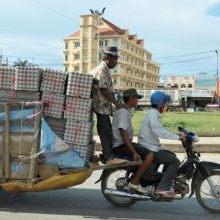
Migrant Workers in Asia Face Unexpected Challenges
Migrant Workers in Asia Face Unexpected Challenges
The 21st century, according to The Guardian, will be defined by the issue of migration. While the spotlight on migration in 2015 has been on the surge of refugees and asylum seekers from the Middle East and Southeast Asia, the study and press coverage of Asian workers migrating within Asia has been an undercurrent since the 1960s.
Southeast Asia is one of the continent’s largest providers of workers, with approximately 2.5 million Asian workers leaving their country of origin every year. Indonesia, the Philippines and Vietnam are considered to be “sending” countries that supply workers, while Singapore, Malaysia and Brunei are major destination points for migrants. Thailand and Malaysia, however, are known as sending and receiving nations.
The usual destinations for both male and female laborers include Southeast Asia and East Asia, but a smaller number of workers from the Philippines and Indonesia frequently migrate to the Arabian Peninsula in West Asia. As for South Asian migrant workers, the vast majority consider the Middle East to be a “favored destination,” while China has seen a huge influx in the supply of workers who migrate from Southeast Asia.
DIRTY, DANGEROUS AND DIFFICULT
Labor migration within Asia is usually a temporary arrangement. Laborers often perform “3D” jobs— dirty, dangerous and difficult—that are shunned by the local population. To maximize profits and reduce costs, local and multinational companies hire migrant workers throughout various industries. Male migrant workers make up 57% of the migrant labor supply within Southeast Asia, who are largely employed as laborers in the construction and manufacturing industries.
Between 1960 and 2000, the number of workers migrating within Southeast Asia grew dramatically, with the flow of migrant workers from Indonesia and Malaysia being the most significant. In 1960, there were 3,200 Indonesian workers, yet this figure jumped to 490,000 by 2000. Most of these workers are hired in the construction, manufacturing, services, plantation and agricultural sectors. Besides Indonesia, workers from other Southeast Asian states (the Philippines, Thailand and Myanmar) and South Asian countries (Bangladesh, Pakistan and India) move to Malaysia to seek employment—making Malaysia a popular receiving country within South-South migration.
Malaysia’s role as a “sending” country, however, has chiefly been to Brunei and Singapore, and this outflow has increased since 1960. The number of male Malaysian workers moving to Singapore for work rose from 68,000 to 315,000 between 1960 and 2000; in Brunei, the number of Malaysian workers present during the same period increased from just 7,000 to 31,000.
Thailand has also become an important labor receiving country within Southeast Asia for the last 15 years, particularly from neighboring Myanmar, Laos and Cambodia. Male migrants from Myanmar working in Thailand have experienced a ten-fold increase, and this leap largely illustrates the growing trend of Asia’s reliance on migrant labor.
In recent years, there has also been an increase of labor migrants originating from Nepal and Pakistan. Based on figures from the World Bank’s Global Migration database, the number of migrant workers from Nepal to Thailand has increased by more than 240% within a decade. In 1990, 3,150 Nepalese workers moved to Thailand to work, and in 2000, this reached nearly 11,000 people.
BENEFITS AND CHALLENGES
Working abroad has benefitted many of these sending countries financially. With workers sending their earnings back home, countries in South and Southeast Asia are the top ten countries to receive migrant remittances. In 2012, India topped the list, receiving $70 billion, followed by China with $66 billion, while Mexico came in third; fourth was the Philippines, which received migrant remittances of $24 billion. Other Asian countries include Bangladesh and Vietnam, receiving $14 billion and $9 billion respectively. Remittances contribute to a significant portion of gross domestic product (GDP) for some of these labor sending countries, such as the Philippines (12.6%), Bangladesh (12%) and Vietnam (6.9%).
Having large groups move across countries to live and work brings with it significant challenges to both the host societies and the migrant workers. While the local population is able to voice their grievances or issues affecting them, most migrant workers do not have such access or privilege to express their concerns or address these challenges. Migrants fear deportation as their stay is tightly regulated. As they come from economically “inferior” countries to perform “3D” labor as a transient migrant worker, this leaves most of them in a catch-22 situation.
Concerns about low wages and dismal working conditions faced by migrant workers have been raised by various nongovernmental organizations, researchers and journalists. However, social and psychological challenges—such as the stigma associated with menial labor, social exclusion and xenophobia—faced by migrant workers are also important areas requiring more attention. While these issues affect both male and female workers, some of these challenges are gender specific.
As gender, ethnicity and class intersect, male migrant workers from certain nations have been stereotyped to be “dangerous.” These assumptions can exacerbate fear among the local population and cause them to exclude these workers from their everyday spaces—such as Qatar, Singapore’s Little India or Abu Dhabi.
Being away from their families for prolonged periods and being excluded in a host country also affects the psychosocial wellbeing of these migrant workers, leading to stress and depression.
In Amnesty International’s 2013 report, the organization highlighted that Indian workers in a Qatari camp were so distraught with challenges they were facing—caught in a legal battle with unpaid wages—that it began taking a psychological toll on them. Several workers planned to commit suicide. The following year, 800 South Asian migrant workers were reported to have died in Qatar since 2012. The situation of these migrant workers has yet to improve.
Coming from different cultural backgrounds and speaking another language are some of the many challenges faced by these workers. As they are seen as temporary workers, however, these considerations tend to be largely ignored. By and large, access to health care facilities and services remains a major concern for migrant workers in Asia.
As male migrants are involved in labor intensive work such as construction and manufacturing, significant occupational risks exist that could affect their health and wellbeing. Most of the workers in these countries do not have equal access to affordable primary health care, as migrants are often assumed to be a burden on the host country’s health system. Language and culture create significant barriers to accessing health care, as migrant workers are often unaware of such health provisions. While it has been made mandatory for employers to provide basic medical services to migrant workers in countries such as Singapore, this is hard to monitor and enforce.
Another growing concern is the spread of HIV, which has been highlighted as a principle health challenge facing migrant workers. Being in foreign lands and separated from their families for extended periods of time, and feeling lonely and isolated, some of these men participate in risky behavior such as visiting brothels. If they test positive for HIV in host countries, most of them face summary deportation.
KEEPING ECONOMIES GOING
Labor migration will continue to grow in Southeast Asia and throughout the Asian continent. Fueled by economic growth, industries such as construction continue to expand. Increasing urbanization will lead to a rise in the demand for construction workers within Southeast Asian countries.
Labor shortages caused by a better educated local population that is unwilling to work in harsh conditions for low wages, and an ageing population pushed by a falling fertility rate, will require more migrant labor to take up essential jobs that keep economies running. Thailand and Singapore are two such examples where fertility rates have fallen below replacement levels.
Sending migrant workers abroad reduces unemployment back home and, at the same time, contributes significantly to a nation’s GDP. Hence, countries such as the Philippines have adopted migrant remittances as part of their national development and long-term growth strategies.
Countries facing labor shortages have begun hiring migrant labor to ensure continuous development, but it is imperative that concerns such as the psychosocial wellbeing of workers are factored into policymaking from both sending and receiving countries.
http://www.fairobserver.com/region/central_south_asia/migrant-workers-in-asia-face-unexpected-challenges-31011/
 Reload
Reload



